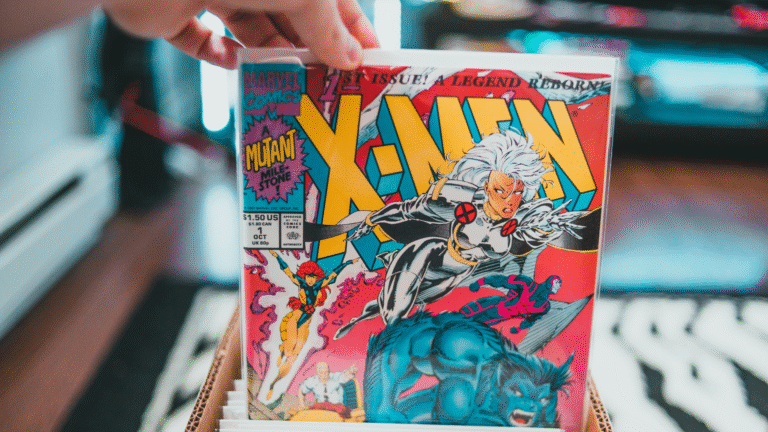Collecting comics can be an exciting and rewarding hobby for enthusiasts of all ages. Understanding the basics of comic book collecting, including how to identify valuable editions and build a diverse collection, is crucial for both new and seasoned collectors. Fans often find joy in hunting for rare issues, attending comic conventions, and connecting with fellow collectors who share their passion.
The world of comic books is vast, encompassing numerous genres, artists, and publishers. From classic superhero tales to independent graphic novels, there is something for everyone. Collectors not only appreciate the artistic and narrative aspects but also the investment potential that certain comics can represent.
Successful comic book collecting involves research and strategy. Knowing about condition grading, storage techniques, and market trends can enhance the collecting experience. With the right approach, anyone can cultivate a meaningful collection that reflects their interests and may grow in value over time.
Getting Started With Collecting Comics
Starting a comic collection can be both exciting and overwhelming. It requires careful thought about focus, building a collection, and proper storage techniques to ensure the longevity of the comics.
Choosing Your Focus
Determining a collection focus is crucial. Many collectors choose specific genres, characters, or publishers. For instance, some might focus on superheroes like Batman, Spider-Man, or teams such as the X-Men.
Consider interests in modern comics or classic issues. Narrowing down preferences helps avoid impulse purchases and can enhance the collecting experience. Popular choices include specific story arcs, characters, or even particular artists. Researching available comics can lead to informed decisions.
Building Your Comic Collection
Building a comic collection involves various steps. Collectors can start with new releases from local comic shops or explore online marketplaces.
Creating a list of desired comics is effective. This list can include titles such as Aquaman or The Flash, focusing on storylines or covers that appeal to the collector.
Networking with other collectors through forums or events can provide valuable tips and leads on rare issues. In addition, attending comic conventions can expose collectors to unique finds.
Storing and Protecting Comics
Proper storage is essential for maintaining a comic’s condition. Using comic boxes is a common method; these boxes protect comics from dust and physical damage.
Using acid-free bags and boards provides further protection against bending and deterioration. It’s essential to store comics upright to avoid spine damage.
Temperature and humidity control will help preserve the comic’s quality over time. Ideally, comics should be stored in a cool, dry place, away from direct sunlight. Following these practices will ensure comics remain in good condition for years to come.
Understanding Comic Book Values and Key Issues
Comic book values are influenced by several factors, including rarity, condition, and historical significance. Key issues often drive demand, while grading systems help collectors assess a comic’s quality.
Identifying Key Issues
Key issues are comics that hold significant cultural or historical importance. These titles often involve the first appearances of iconic characters or pivotal storylines.
For example:
- Action Comics #1: First appearance of Superman.
- Detective Comics #27: Introduction of Batman.
- Wonder Woman #1: Debut of the iconic female superhero.
Collectors seek these issues for their investment potential and cultural relevance. A comic can be highly sought after simply due to a character’s popularity or a significant storyline development, impacting its market value.
Grading and CGC Certification
Grading is crucial in determining a comic’s value. The Certified Guaranty Company (CGC) provides a standardized grading system from 0.5 to 10. A higher grade signifies better condition and can exponentially increase value.
Key grades include:
- NM+ (9.6): Near Mint Plus – minimal wear.
- VF (8.0): Very Fine – minor wear but impressive overall.
- CGC 9.8: Highly desired for modern comics, indicating pristine condition.
CGC certification adds credibility and can significantly enhance resale value, making it essential for serious collectors.
Golden Age and Iconic Comics
The Golden Age of comics, spanning from the late 1930s to the early 1950s, produced some of the most valuable issues. These comics laid the foundation for modern superhero tales.
Notable Golden Age titles include:
- All-Star Comics #8: First appearance of the Justice Society.
- Flash Comics #1: Debut of the Flash.
- Sensation Comics #1: Introduction of Wonder Woman.
These early issues have become iconic and are often the cornerstone of any serious collection due to their historical significance and rarity.
Most Valuable Comic Books
Certain comic books have achieved record-breaking values at auctions. The following titles are among the most valuable:
- Action Comics #1 – Sold for over $3 million.
- Detective Comics #27 – Reached prices around $2 million.
- All-Star Comics #8 – Fetches $1 million or more.
Additionally, early appearances of characters like Lex Luthor and side stories featuring Jimmy Olsen in titles like Action Comics #60 can also command high prices in excellent condition. Collectors often focus on these iconic works to build a valuable collection.
Exploring the World of Comics
The landscape of comics includes iconic characters, influential publishers, and various formats that collectors find appealing. This section examines notable storylines, important publishers, and special editions that enhance the comic collecting experience.
Famous Storylines and Characters
Comic book history is marked by renowned characters and story arcs. Notable examples include Batman #1, which introduced the Joker and Catwoman, setting a standard for superhero storytelling. Action Comics #1 is significant as it marked the debut of Superman, revolutionizing the genre.
Amazing Spider-Man has also seen critical acclaim, particularly its exploration of personal struggles faced by Peter Parker. These storylines not only entertain but define the essence of the characters, creating lasting connections with readers.
Publishers and Reprints
DC Comics and Marvel Comics are the two primary publishers shaping the comic industry. DC’s influence is evident through series like All-American Comics, which introduced Green Lantern, while Marvel created a unique universe featuring characters like Spider-Man.
Reprints serve to keep classic stories accessible. They provide readers an opportunity to engage with pivotal arcs without hunting down rare first editions. Many key issues are reprinted multiple times, ensuring that significant storylines remain within reach for new and seasoned collectors.
Omnibus Editions and Volumes
Omnibus editions compile extensive story arcs into comprehensive volumes. This format presents readers with a cohesive narrative experience across multiple issues.
For instance, certain Batman storylines are available in omnibus format, allowing collectors to own several pivotal tales in one collection. This format is ideal for immersing oneself in a character’s journey without the need to locate individual back issues.
Collecting these editions provides a convenient way to explore various storylines and appreciate the evolution of beloved characters. Omnibus volumes often feature extensive annotations and artwork, enhancing the overall reading experience.







Recent Comments